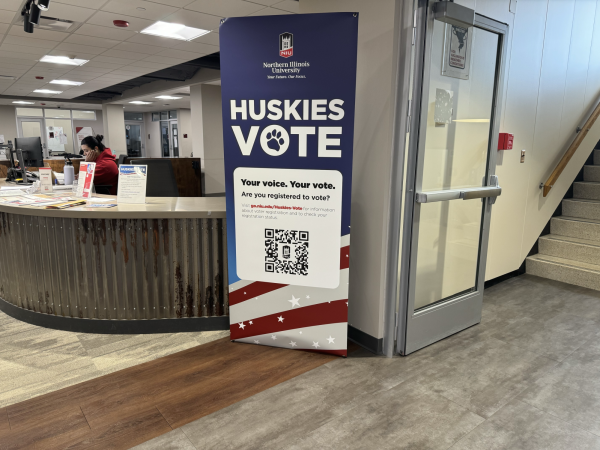Test kitchen moniters food quality
March 6, 1989
Where can you go to taste free food, plan special dinners for NIU residence halls or observe a Human and Family Resources class learn about sensory perception? The answer is Douglas Hall’s test kitchen.
Patty Lee, NIU food specialist, said the test kitchen is a quality_control function. It is easier to test the food in a separate kitchen apart from the cafeteria because it is quieter and more isolated, she said.
Test Kitchen Manager Barb Donohue said the test kitchen is also a training facility. Every new cook and cook’s helper working in residence hall food service trains for two days, seven and a half hours each day, she said. They learn how to use the equipment, make recipes and learn about safety and sanitation. There also is a slide presentation on how to use the equipment.
“Northern is one of a few schools that has a test kitchen,” she said.
The test kitchen performs two types of judging—formal and informal. During the formal judging there are separate booths, “so you can’t look across the room and smile at each other and say this tastes terrible,” Donohue said.
“We don’t have a regular basis for testing. We do informal testing once or twice a week,” she said.
The food is rated in four different categories: color, uniformity and general characteristic, flavor and odor and texture and consistency. Each category has a different numerical value, depending on which trait is more important.
For example, the highest score for color is a six, and the highest for flavor and odor is eight. At the end of the judging, the scores are tallied. The passing score of a particular food is 18.
“No matter what it looks like, if it doesn’t taste good, people aren’t going to eat it,” Donohue said.
Donohue said a numerical rating is used in order to judge food against other products. The comment “‘good’ doesn’t say anything.”
An informal judging is handled by the student food advisory board. On Tuesday, the students tested chicken grill—a chicken patty grilled like a hamburger—and Mexican pizza.
“We’re customer-oriented. Students are customers. Sometimes managers are 20 years older than students and have different tastes. Students may like things a little spicier than managers,” Donohue said.
“We’re never going to find 100 percent agreement with everybody. We’re trying to serve the majority of the people with a little variety,” she said.
Since June, 1988, Donohue has tested 500 items and expects to exceed that number by the end of this semester.
Lee said students who live closest to Douglas Hall, such as in Stevenson and Grant Towers, participate in the testing. She said she would like to see student participants from every hall.
There are usually six or seven testers. The highest has been 12, while the lowest has been two.
“We always look for ideas. We would like to do things that are more authentic,” Lee said. Some students asked about servng authentic food during February’s Black History Month, while some Malaysian students have asked for food they are accustomed to eating.
“If we’re not familiar with a food, we can research it. It helps if someone has lived the culture and is used to buying the ingredients and can give you advice,” Lee said.
Some of the more successful test kitchen entrees have been the beef and chicken fajitas, chicken tenderloins and nuggets.
Some foods that failed have been “gyros on a skew” and breaded pickles. “They were OK, but they were too hot and would burn your mouth inside,” Lee said.
Reduced and no sodium soups also have been tested. A few weeks ago at Douglas Hall, students sampled cream of broccoli soup and potato chowder. “The no sodium was not accepted very well, particularly in the potato because it didn’t have the flavor you normally expected. The low sodium broccoli went very well because of the cheese,” Lee said.
Donohue said a survey showed most students prefer reduced sodium over no-sodium soups.
Sally LoChirco, a Douglas Hall food service employee, said , “During crewline dinner they give us portions to taste. The other day they served funky lasagna.”
Lee said ideas for the test kitchen come from co_workers, cookbooks or other universities. Donohue also said food brokers have new products they want sampled.
The test kitchen also works on special dinners. During Unity through Diversity week, the food service tried to have an ethnic meal each day.
A Scandinavian Smorgasbord is planned for Mar. 23. Some items that will be served were tested in the test kitchen, such as dill baked cod, Swedish meatballs and currant sauce for pudding.
Donohue said twice a semester, a Human and Family Resources class on sensory perception learns how to judge food and how to do taste tests.
The testing kitchen operates on the first and third Tuesday of the month at 3:30 p.m.
Lee said flyers are posted by cafeteria menus announcing test kitchen dates and announcements are made at the Residence Hall Association’s meetings.
“I consider the test kitchen as a reference. We have records from 25 years ago and look back to see how menus have changed,” Donohue said.
“No matter what it looks like, if it doesn’t taste good, people aren’t going to eat it.”
Barb Donohue, test kitchen manager












